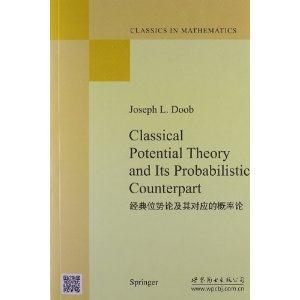-
>
宇宙、量子和人類心靈
-
>
氣候文明史
-
>
南極100天
-
>
考研數(shù)學(xué)專題練1200題
-
>
希格斯:“上帝粒子”的發(fā)明與發(fā)現(xiàn)
-
>
神農(nóng)架疊層石:10多億年前遠古海洋微生物建造的大堡礁
-
>
聲音簡史
經(jīng)典位勢論及其對應(yīng)的概率論 版權(quán)信息
- ISBN:9787510058417
- 條形碼:9787510058417 ; 978-7-5100-5841-7
- 裝幀:一般膠版紙
- 冊數(shù):暫無
- 重量:暫無
- 所屬分類:>>
經(jīng)典位勢論及其對應(yīng)的概率論 本書特色
《經(jīng)典位勢論及其對應(yīng)的概率論(英文)》由世界圖書出版公司北京公司出版。
經(jīng)典位勢論及其對應(yīng)的概率論 內(nèi)容簡介
Potential theory and certain aspects of probability theory are intimately related, perhaps most obviously in that the transition function determining a Markov process can be used to define the Green function of a potential theory. Thus it is possible to define and develop many potential theoretic concepts probabilistically, a procedure potential theorists observe with jaun- diced eyes in view of the fact that now as in the past their subject provides the motivation for much of Markov process theory. However that may be it is clear that certain concepts in potential theory correspond closely to concepts in probability theory, specifically to concepts in martingale theory.For example, superharmonic functions correspond to supermartingales. More specifically: the Fatou type boundary limit theorems in potential theory correspond to supermartingale convergence theorems; the limit properties of monotone sequences of superharmonic functions correspond surprisingly closely to limit properties of monotone sequences of super- martingales; certain positive superharmonic functions [supermartingales] are called "potentials," have associated measures in their respective theories and are subject to domination principles (inequalities) invomng the supports of those measures; in each theory there is a reduction operation whose properties are the same in the two theories and these reductions induce sweeping (balayage) of the measures associated with potentials, and,so on.
經(jīng)典位勢論及其對應(yīng)的概率論 目錄
Notation and Conventions
Part 1
Classical and Parabolic Potential Theory
Chapter I
Introduction to the Mathematical Background of Classical Potential Theory
1.The Context of Green's Identity
2.Function Averages
3.Harmonic Functions
4.Maximum-Minimum Theorem for Harmonic Functions
5.The Fundamental Kernel for RN and Its Potentials
6.Gauss Integral Theorem
7.The Smoothness of Potentials ; The Poisson Equation
8.Harmonic Measure and the Riesz Decomposition
Chapter II
Introduction
Notation and Conventions
Part 1
Classical and Parabolic Potential Theory
Chapter I
Introduction to the Mathematical Background of Classical Potential Theory
1.The Context of Green's Identity
2.Function Averages
3.Harmonic Functions
4.Maximum-Minimum Theorem for Harmonic Functions
5.The Fundamental Kernel for RN and Its Potentials
6.Gauss Integral Theorem
7.The Smoothness of Potentials ; The Poisson Equation
8.Harmonic Measure and the Riesz Decomposition
Chapter II
Basic Properties of Harmonic, Subharmonic, and Superharmonic Functions
1.The Green Function of a Ball; The Poisson Integral
2.Hamack's Inequality
3.Convergence of Directed Sets of Harmonic Functions
4.Harmonic, Subharmonic, and Superharmoruc Functions
5.Minimum Theorem for Superharmonic Functions
6.Application of the Operation TB
7.Characterization of Superharmonic Functions in Terms of Harmonic Functions
8.Differentiable Superharmonic Functions
9.Application of Jensen's Inequality
10.Superharmonic Funaions on an Annulus
II.Examples
12.The Kelvin Transformation
13.Greenian Sets
14.The L1(uB_) and D(uB_) Classes of Harmonic Functions on a Ball B; The
Riesz-Herglotz Theorem
15.The Fatou Boundary Limit Theorem
16.Minimal Harmonic Functions
Chapter III
Infima of Families of Superharmonic Functidns
1.Least Superharmonic Majorant (LM) and Greatest Subharmonic Minorant (GM)
2.Generalization of Theorem I
3.Fundamental Convergence Theorem (Preliminary Version)
4.The Reduction Operation
5.Reduction Properties
6.A Smallness Property of Reductions on Compact Sets
7.The Natural (Pointwise) Order Decomposition for Positive Superharmonk
Functions
Chapter 1V
Potentials on Special Open Sets
1.Special Open Sets, and Potentials on Them
2.Examples
3.A Fundamental Smallness Property of Potentials
4.Increasing Sequences of Potentials
5.Smoothing of a Potential
6.Uniqueness of the Measure Determining a Potential
7.Riesz Measure Associated with a Superharmonic Function
8.Riesz Decomposition Theorem
9.Counterpart for Superharmonic Functions on R2 ofthe Riesz
Decomposition
10.An Approximation Theorem
Chapter V
Polar Sets and Their Applications
1.Definition
2.Superharmonic Functions Associated with a Polar Set
3.Countable Unions of Polar Sets
4.Properties ofPolar Sets
5.Extension of a Superharmonic Function
6.Greenian Sets in IR2 as the Complements of Nonpolar Sets
7.Superharmonic Function Minimum Theorem (Extension of Theorem I1.5)
8.Evans-Vasilesco Theorem
9.Approximation of a Potential by Continuous Potentials
10.The Domination Principle
I1.The Infinity Set of a Potential and the Riesz Measure
……
Part 2
Probabilistic Countrepart of Part 1
Part 3
經(jīng)典位勢論及其對應(yīng)的概率論 節(jié)選
《經(jīng)典位勢論及其對應(yīng)的概率論(英文)》由世界圖書出版公司北京公司出版。
經(jīng)典位勢論及其對應(yīng)的概率論 作者簡介
Joseph L. Doob是國際知名學(xué)者,在數(shù)學(xué)和物理學(xué)界享有盛譽。本書凝聚了作者多年科研和教學(xué)成果,適用于科研工作者、高校教師和研究生。
- >
伊索寓言-世界文學(xué)名著典藏-全譯本
- >
山海經(jīng)
- >
煙與鏡
- >
隨園食單
- >
伯納黛特,你要去哪(2021新版)
- >
中國歷史的瞬間
- >
唐代進士錄
- >
推拿















